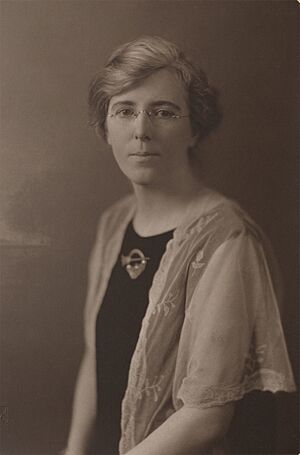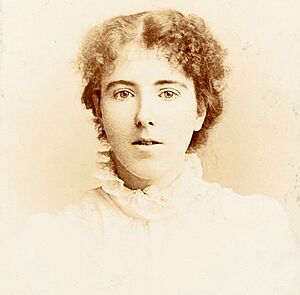Kathleen Clarke facts for kids
Quick facts for kids
Kathleen Clarke
|
|
|---|---|

Clarke in 1924
|
|
| Lord Mayor of Dublin | |
| In office June 1939 – June 1941 |
|
| Preceded by | Alfie Byrne |
| Succeeded by | Peadar Doyle |
| Dublin Corporation | |
| In office 1930–1942 |
|
| Senator | |
| In office 12 December 1928 – 29 May 1936 |
|
| Teachta Dála | |
| In office June 1927 – September 1927 |
|
| Constituency | Dublin North |
| In office May 1921 – June 1922 |
|
| Constituency | Dublin Mid |
| Personal details | |
| Born |
Kathleen Daly
12 April 1878 Limerick, Ireland |
| Died | 29 September 1972 (aged 94) Liverpool, England |
| Resting place | Deans Grange Cemetery, Dublin, Ireland |
| Political party |
|
| Spouse | |
| Children | 3 |
| Military service | |
| Allegiance | Cumann na mBan |
Kathleen Clarke (born Daly; 12 April 1878 – 29 September 1972) was an important Irish leader. She helped start Cumann na mBan, a women's group formed in 1914. This group worked for Irish independence. Kathleen was one of the few people who knew about the secret plans for the Easter Rising in 1916.
Her husband, Tom Clarke, and her brother, Ned Daly, were both executed after the Rising. Kathleen later became a Teachta Dála (TD), which is like a member of parliament. She also served as a Senator. She was a member of both Sinn Féin and Fianna Fáil political parties. In 1939, she made history as the first female Lord Mayor of Dublin.
Contents
Early Life and Family
Kathleen Daly was born in Limerick, Ireland, on 12 April 1878. She was the third daughter of Edward and Catherine Daly. Her family was known for being involved in Irish nationalist movements. Her uncle, John Daly, was a Fenian, a member of a secret Irish revolutionary group. He was in prison for his political actions when Kathleen was young.
In 1896, her uncle was released from prison. Around this time, Kathleen started her own business selling fabric. In 1898, Tom Clarke, who had been in prison with her uncle, visited the Daly family. Kathleen and Tom fell in love.
In 1901, Kathleen moved to the United States to join Tom. They got married in New York City on 16 July 1901. They had three children together. While in the US, Kathleen joined the Gaelic League, which promoted the Irish language. In 1907, they returned to Ireland and opened a shop selling tobacco.
Role in Cumann na mBan
In 1914, Kathleen became a founder of Cumann na mBan. This group played a big part in the fight for Irish freedom. Kathleen's husband, Tom Clarke, did not want her to fight directly in the 1916 Easter Rising. He wanted her to be safe and ready to help no matter what happened.
Tom Clarke was the first person to sign the Proclamation of the Irish Republic, a document declaring Ireland's independence. Because of this, he was chosen to be executed after the Rising. Her younger brother, Ned Daly, was also executed for his part in the rebellion. Kathleen visited both of them before they died. She was pregnant at the time but sadly lost the baby.
Kathleen was determined to keep fighting for Irish independence. She said she wanted to "keep the ball rolling" and continue the fight for freedom. After the Rising, Michael Collins contacted her from prison. He wanted to rebuild the Irish independence movement. Kathleen also started the Irish National Aid Fund. This fund helped families whose loved ones were killed or imprisoned because of the Easter Rising.
Political Journey
Joining Sinn Féin
Kathleen Clarke joined the political party Sinn Féin. In 1917, she was elected to the party's main committee. She was arrested and held in prison for nearly a year during a time when the British government suspected a "German Plot" in Ireland.
During the Irish War of Independence, Kathleen served as a judge in the Republican Courts in Dublin. These courts were set up by Irish nationalists. In 1919, she was elected as an Alderman for Dublin Corporation. This was a local government role. She also worked with the Irish White Cross, an organization that helped people affected by the conflict.
In 1921, Kathleen was elected to the Second Dáil, which was the Irish parliament. She represented the Dublin Mid area. She strongly disagreed with the Anglo-Irish Treaty. This treaty created the Irish Free State but kept Ireland linked to the British Empire. She was not re-elected in 1922. During the Irish Civil War, she supported the Anti-Treaty side. Her shop was often searched by the police.
With Fianna Fáil
In 1926, Kathleen helped start a new political party called Fianna Fáil. She had to leave Cumann na mBan to join this party. She was elected to the Dáil again in June 1927 but lost her seat a few months later. In 1928, she was elected as a Senator to the Free State Seanad (Senate). She served there until 1936.
In 1930, she was elected to the Dublin Corporation again. From 1939 to 1941, Kathleen Clarke became the first ever female Lord Mayor of Dublin. This was a very important achievement. She disagreed with parts of the Constitution of Ireland. She felt that some sections would put women in a lower position than they deserved. She spoke out about this in the newspapers.
Kathleen also disagreed with some of Fianna Fáil's policies. She asked for mercy for Irish Republican Army (IRA) members who were sentenced to death during World War II. This led to her leaving the party after her time as Lord Mayor ended in 1941. She also opposed the government taking too much control over local councils. She did not run for election with Fianna Fáil in 1943. While Lord Mayor, she helped create the Irish Red Cross.
In 1948, she tried to get elected to the Dáil again with a different party, Clann na Poblachta, but she was not successful.
Later Years and Legacy
In 1966, Ireland celebrated 50 years since the Easter Rising. Kathleen Clarke and other surviving family members received special honors from the National University of Ireland.
Kathleen felt strongly that her husband, Tom Clarke, should be remembered as the true leader of the 1916 Rising. She believed he was the President of the Republic, not Patrick Pearse. She wanted a central role in the celebrations. She said she knew more about the events of that time than anyone else alive.
Kathleen Clarke passed away in 1972 at the age of 94 in Liverpool, England. She was given a rare state funeral, which is a great honor. She is buried in Deans Grange Cemetery, Dublin. She preferred to be known as Caitlín Bean Uí Chléirigh, which means Kathleen, Mrs. Clarke, and this is on her headstone. Her grand-niece, Helen Litton, later put together Kathleen's life story in a book.
An apartment building in Ballybough, Dublin, is named 'Kathleen Clarke Place' in her honor.
Images for kids




